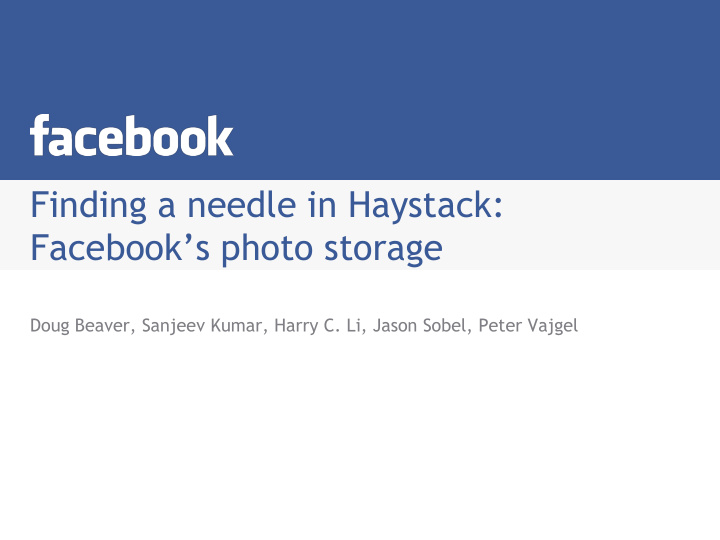



Finding a needle in Haystack: Facebook’s photo storage Doug Beaver, Sanjeev Kumar, Harry C. Li, Jason Sobel, Peter Vajgel
Photos @ Facebook April 2009 Current 15 billion photos 65 billion photos Total 60 billion images 260 billion images 1.5 petabytes 20 petabytes 220 million photos / week 1 billion photos / week Upload Rate 25 terabytes 60 terabytes Serving Rate 550,000 images / sec 1 million images / sec
NFS based Design NAS NAS NAS Web Server NFS 6 5 Photo Store Photo Store Server Server 1 2 7 4 3 CDN Browser 8
NFS based Design Typical website – Small working set – Infrequent access of old content – ~99% CDN hit rate Facebook – Large working set – Frequent access of old content – 80% CDN hit rate
NFS based Design Metadata bottleneck – Each image stored as a file – Large metadata size severely limits the metadata hit ratio Image read performance ~10 iops / image read (large directories – thousands of files) ~3 iops / image read (smaller directories – hundreds of files) ~2.5 iops / image read (file handle cache)
Haystack based Design Haystack Store Haystack Directory Web Haystack Server Cache CDN Browser
Haystack Store Replaces Storage and Photo Server in NFS based Design Haystack Photo Server Haystack Filesystem Storage
Haystack Store Storage – 12x 1TB SATA, RAID6 Filesystem – Single ~10TB xfs filesystem Haystack – Log structured, append only object store containing needles as object abstractions – 100 haystacks per node each 100GB in size
Haystack Store – Haystack file Layout Superblock Header Magic Number Cookie Needle 1 Key Alternate Key Flags Size Needle 2 Data Footer Magic Number Data Checksum Needle 3 Padding
Haystack Store – Haystack Index File Layout Superblock Key Needle 1 index record Alternate Key Flags Needle 2 index record Offset Needle 3 index record Size
Haystack Store - Photo Server Accepts HTTP requests and translates them to corresponding Haystack operations Builds and maintains an incore index of all images in the Haystack 32 bytes per photo (8 bytes per image vs. ~600 bytes per inode) ~5GB index / 10TB of images 64-bit photo key 1 st scaled image 32-bit offset / 16-bit size 2 nd scaled image 32-bit offset / 16-bit size 3 rd scaled image 32-bit offset / 16-bit size 4 th scaled image 32-bit offset / 16-bit size
Haystack Store Operations Read – Lookup offset / size of the image in the incore index – Read data (~1 iop) Multiwrite (Modify) – Asynchronously append images one by one to the haystack file – Flush haystack file – Asynchronously append index records to the index file – Flush index file if too many dirty index records – Update incore index
Haystack Store Operations Delete – Lookup offset of the image in the incore index – Synchronously mark image as “DELETED” in the needle header – Update incore index Compaction – Infrequent online operation – Create a copy of haystack skipping duplicates and deleted photos
Haystack based Design Haystack Store Haystack Directory Web Haystack Server Cache CDN Browser
Haystack Directory Logical to physical volume mapping – 3 physical haystacks (on 3 nodes) per one logical volume URL generation – http://<CDN>/<Cache>/<Node>/<Logical volume id, Image id> Load Balancing – Writes across logical volumes – Reads across physical haystacks Caching strategy – External CDN or Local cache?
Haystack based Design - Photo Upload Haystack Store Haystack Directory 2 3 4 Web Haystack Server Cache 1 5 CDN Browser
Haystack based Design – Photo Download Haystack Store Haystack Directory 2 3 7 8 Web Haystack Server Cache 6 9 1 4 5 CDN Browser 10
Conclusion Haystack – simple and effective storage system – Optimized for random reads (~1 I/O per object read) – Cheap commodity storage – 8,500 LOC (C++) – 2 engineers 4 months from inception to initial deployment Future work – Software RAID6 – Limit dependency on external CDN – Index on flash
Q&A Thanks!
Recommend
More recommend